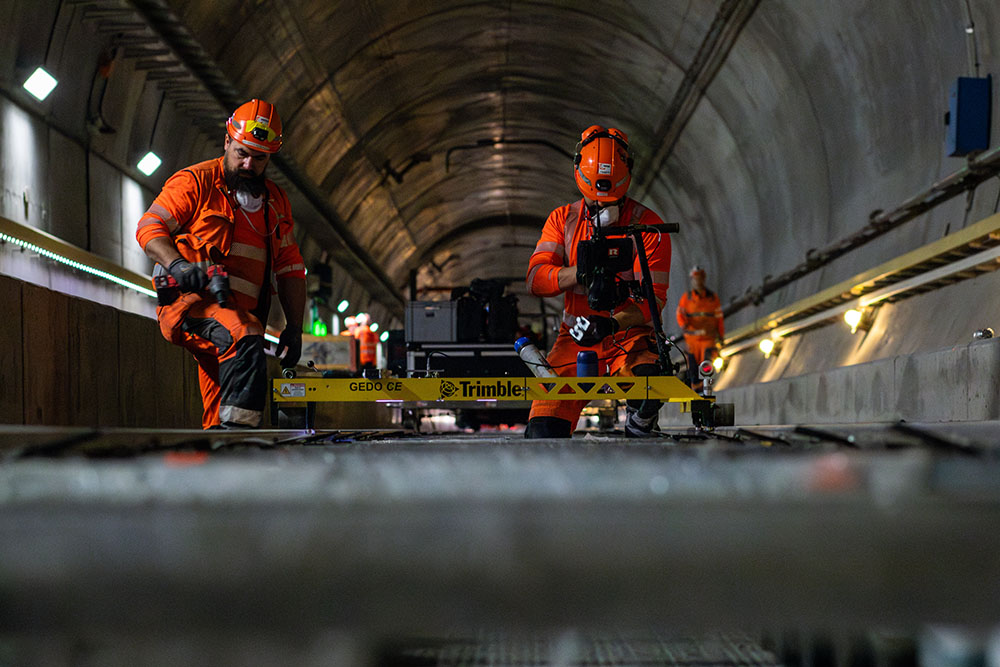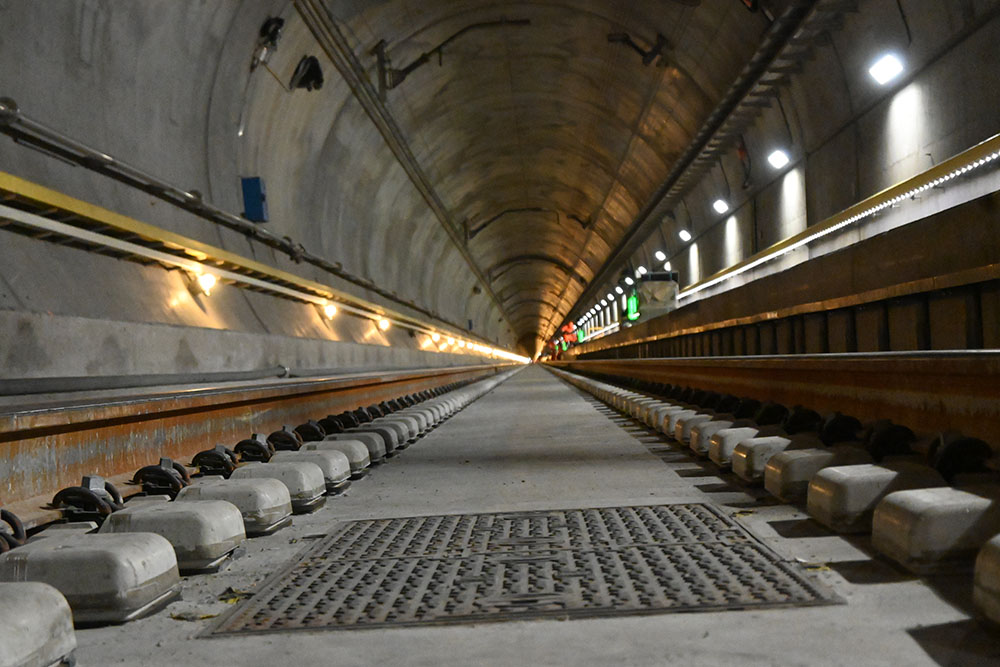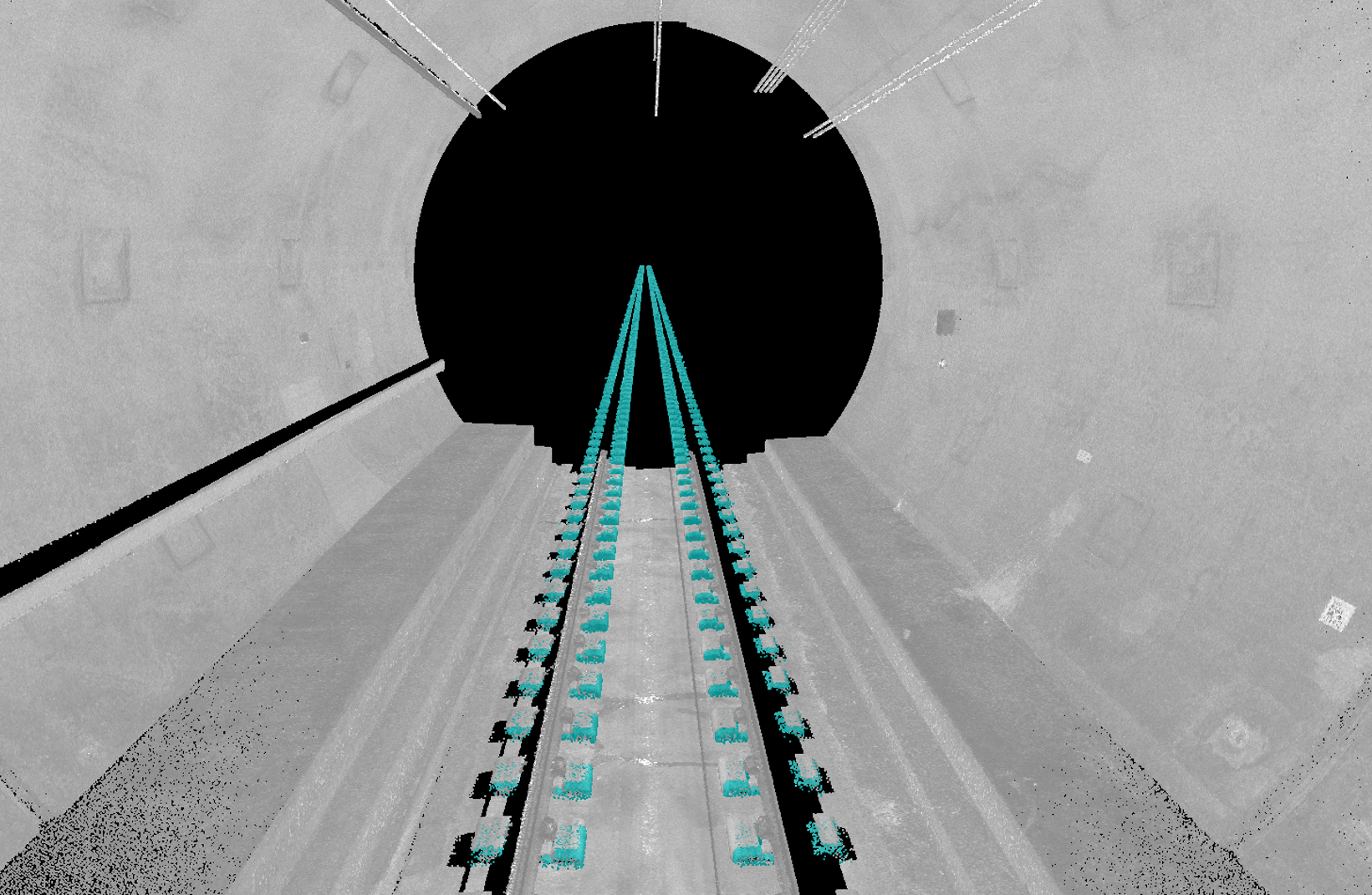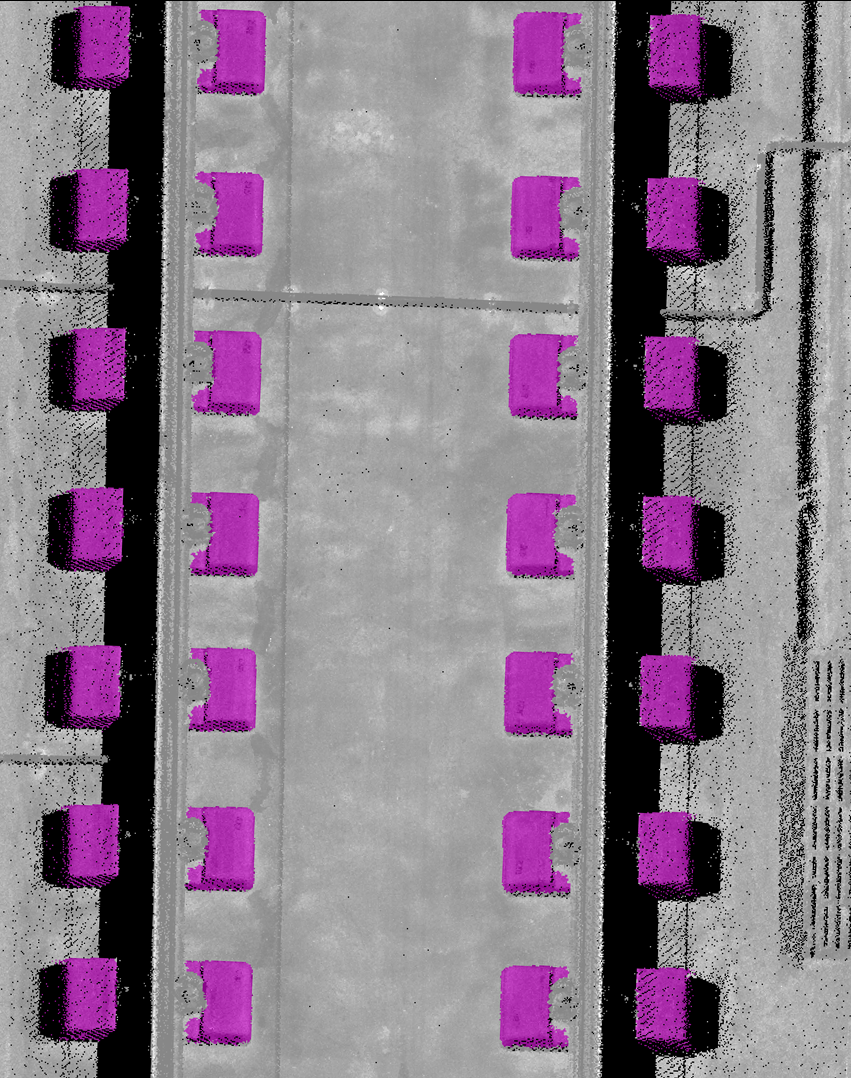Smart automation for big data: Custom feature extraction applied to rail lines expedites analysis and improves safety
AI models in Trimble Business Center were trained to extract 20,000 rail sleepers from a point cloud, drastically reducing the time needed to identify anomalies.
By Linda Duffy
Rail lines are carefully engineered to evenly distribute the weight of massive locomotives and cars carrying tons of freight and passengers every day around the world. Small variations in track width or height may result in vibrations and inefficient energy use, while more serious issues can lead to derailments and high-speed accidents. Innovative rail companies like Rhomberg Sersa Rail Group (RSRG) are adopting new methods of monitoring, inspecting and analyzing rail infrastructure during and after construction with the help of technology including 3D laser scanners and artificial intelligence (AI) to improve safety and assist with long-term lifecycle management.
Gotthard Base Tunnel project
In August 2023, Switzerland’s Gotthard Base Tunnel sustained significant damage during a 16-car derailment that shut down all passenger and cargo travel through the western tube for over one year. The 35-mile-long rail tunnel — the longest in the world — is an important transportation link between Germany to the north and Italy to the south.
RSRG is an international expert in end-to-end rail construction, providing a range of services including reality data capture, support planning, construction and deformation monitoring. After the accident at Gotthard, the firm was contracted to complete the repair work, including dismantling the damaged track and installing and aligning a new Low Vibration Track (LVT system) over a four-mile distance. All contractors were under pressure to complete construction quickly so tunnel operations could resume. The high-profile project required high accuracy and careful logistical planning under challenging conditions with high humidity and poor air quality inside the tunnel.
Just before completion of the construction, the tunnel owner asked if the RSRG team could complete a quality check on each of the 20,000 sleepers to confirm proper alignment and ensure that spacing between the blocks fell within the tolerance of 6 cm (+/- 2 cm).
Dimitrios Kyritsis, RSRG’s digital rail services manager, explained his company’s philosophy, “Our Rail Department experiments with new technology to make operations more efficient and safer as travel speeds continue to increase. We consider ways to use technology to meet the customers’ needs while optimizing the number of people and the number of hours in the field to save money and reduce risk.”
After considering the options, RSRG felt manual measuring would require too many weeks of labor and delay the opening of the tunnel. Instead, the surveyors decided the most efficient method was to scan the tunnel using a Trimble GEDO IMS-Scan trolley system and then use a new capability in Trimble Business Center (TBC) software to train custom point cloud classification models to extract the sleepers from the point cloud.

The trolley was equipped with a Trimble GEDO GX50 laser scanner consisting of dual head scanners that produced a very dense 360-degree point cloud. To ensure full coverage of the sides of the sleepers, each head was set at an 80-degree orientation and the tunnel was scanned twice—once in each direction. The most recent Trimble GEDO systems include an Inertial Measurement Unit (IMU) to capture positioning data with 3–5 mm accuracy while scanning.
The double profile scanner is ideal for as-is and as-built reality capture for comparison with design models and for quality checks of concrete surfaces, power lines, power rails, sleepers, rail fasteners and rail inclination. RSRG had previously used the Trimble GEDO Track system for slab adjustment and the Trimble GEDO IMS system in combination with a Trimble S9 robotic total station to produce final as-built documentation with an accuracy of +/- 1 mm, but this was their first experience training the AI feature extraction tool in TBC.

Automate workflows with custom AI training
The Trimble GEDO trolley produced 900 point cloud files (500 GB of data) to be processed in Trimble GEDO Scan Office. With an Excel file for control, individual georeferenced point clouds were merged into a large data set. To help isolate the sleepers, noise was removed from the point cloud, retaining only the ground features around the track.
Due to the volume of data, manual feature extraction of the sleepers would have been extremely time intensive and prone to errors. Instead, RSRG experimented with a new tool in TBC that allows users to train 3D deep learning models and customize feature extraction workflows to serve individual domain-specific needs. AI is being used to mimic human cognitive functions with a goal of high-quality replacement, meaning that the result produced by AI-powered tools is expected to be as close as possible to the quality of human intelligence. The productivity gains provided by AI-powered tools are accessible to everyone without requiring AI expertise.
To automate the measuring process, RSRG created sample point cloud data containing manually classified sleepers to train the AI model in TBC. They applied the model to the complete point cloud collected with the Trimble GEDO trolley to automatically classify the sleepers that had been installed in the tunnel.

“We watched free webinars online and experimented with the tool. It was straightforward to learn,” said Kyritsis. “A statistical analysis assessed the training process and indicated whether we needed a bigger area and more training. It was important to us to be able to verify the accuracy of the results, so it wouldn’t be a ‘black box’ for the engineers. We were pleased with our 97% accuracy after training the model.”
After applying the AI model to extract the sleepers, in-house-developed modules compared the 3D model against the reality capture and calculated measurements using a best-fitting approach, taking into account the absolute coordinates from the Trimble GEDO trolley scan. RSRG produced a 340-page report calculating distances at a mm/sub-cm level for all pairs of sleepers and highlighting those that had a gap wider than 2 cm.

“Other software limits the kinds of features we can classify and extract,” said Kyritsis. “TBC offered the capability to train AI for a specific type of sleeper and improve the results. AI allowed us to automate the extraction process and complete the work quickly with confidence in the results.”
AI adds value to big data
There is growing demand for smarter ways to handle large volumes of data as adoption of 3D laser scanners and mobile mappers continues to increase. Automation using AI is a great time saver when processing and analyzing high density reality capture data.
At Gotthard Base Tunnel, the benefits of AI for feature extraction in TBC extended far beyond the initial project. Trained models can be distributed to other offices to detect the same features, so value was created for the whole company. With training files readily accessible, inspections might occur more frequently to be proactive instead of reactive.
The Trimble GEDO trolley captured data quickly and helped avoid further delays to reopening the tunnel. The comprehensive data set documents current conditions that can be compared to future data collections to guide maintenance.
The western tube of the Gotthard Base Tunnel reopened in September 2024, able to accommodate 260 freight trains and 70 passenger trains per day. In the future, at every stage of lifecycle management, digital reality capture data will play an important role in making informed decisions.
